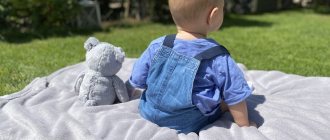The world is filled with thousands of sounds: the sound of rain, birdsong, car horns. We perceive sounds as an integral part of the surrounding reality, because it seems to us that we have always heard them. The auditory analyzer, which is responsible for the perception and recognition of sounds, actually develops and begins to work long before the birth of the child.
The unborn baby hears the mother’s voice, her heartbeat, and noises coming from outside. Therefore, many mothers share with each other memories that attending a rock concert in the late stages of pregnancy did not leave the unborn baby indifferent - he began to move.
But auditory perception develops even more actively after birth. Having lived only 12 hours, the child already distinguishes human speech from other sounds, reacting to it with barely noticeable movements, and can accurately distinguish the mother’s voice from the voices of other people. Modern research shows that an infant is able to perceive the difference between a “native” and an “unfamiliar” language.
French linguist researcher Jacques Meller conducted an experiment in which four-day-old infants from families whose parents spoke French took part. The scientist used specially designed nipples that recorded the frequency of the baby's sucking movements. While feeding, the infants listened to a story recorded on a tape recorder, first in Russian and then in French. When infants heard French speech, they sucked more vigorously, whereas listening to Russian speech did not affect their behavior.
A child’s hearing develops at a rapid pace: at first, the newborn notices only those sounds that are located at a short distance (no more than 1.5 meters) from him. By the end of the year, the distance at which the baby perceives sound increases to six meters. A newborn is not familiar with the variety of environmental sounds. Throughout childhood, the child masters a kind of “sound vocabulary”, “memorizing” a huge number of everyday sounds - laughter, splashing water, creaking doors, squealing brakes, voices of animals, birds, people...
Hearing plays one of the leading roles in the development of speech: listening to the speech of others, the baby remembers the sound of words, rhythmic and intonation features of his native language. The memory of subtle sound nuances allows us much later, when talking on the phone, to accurately distinguish the voices of loved ones by their individual intonations.
In my office there is a young mother and a restless baby who is haunted by the toys on the shelf. Poking her finger at them, she shows us that she wants to play with them. “Here,” my mother says annoyedly, “All she knows is to point a finger when she needs something.” But he can’t ask. But it’s almost three years, big one. Her peers have been speaking in sentences for a long time, but we only have shouts and gestures.
I just can’t understand why he still doesn’t speak. In our family, everyone started talking early - both me and my husband. I really want her to say...” After a long conversation with the mother and examination of the girl, I suggest that they undergo an examination by an audiologist (a specialist who deals with hearing disorders). Mom is surprised; she never expected that the delay in her baby’s speech development is associated with hearing loss. Unfortunately, this case is very typical.
Minor hearing loss is most often perceived by parents as the child’s inattention and therefore is almost not detected at an early age. Parents of children with severe hearing loss begin to suspect that “something is wrong” quite early, usually in the first or second year of the child’s life. They are alarmed by the baby’s obvious ignoring of loud sounds, lack of reaction to his own name, and delayed speech development. One worried grandmother brought her grandson to specialists after testing his hearing using the homemade “saucepan method” - the child did not turn to the sound of two lids hitting.
In the Russian Federation there are currently about 600 thousand children and adolescents with hearing impairment. It is believed that per 1000 physiological births there is 1 child with severe hearing loss. Data on the prevalence of mild and moderate hearing loss still require clarification. This is due to the late referral of children’s parents to specialists, as well as the lack of alertness of pediatricians. In 1/3 of cases, mild and moderate hearing loss is first detected at the age of 3-7 years.
The auditory analyzer is the second human analyzer after the visual one, playing an important role as a component of obtaining information about the world around us. There is a close relationship between the state of hearing and speech development. Therefore, any, and even more severe, hearing impairment in the form of hearing loss and deafness has a great impact on the general and mental development of a growing child: untimely detection of hearing impairment in young children can lead not only to a delay in the speech, but also the intellectual development of the child.
Causes of hearing loss
There are many causes (or risk factors, as doctors call them) that can contribute to hearing loss, but they may not cause hearing loss on their own. Risk factors create a favorable background for the development of the disorder. In most cases, hearing loss is caused by several causes that operate during different periods of a child’s development. A child’s hearing system is especially vulnerable from the fourth week of pregnancy until the baby is four to five years old. Doctors identify three groups of reasons.
The first group is hereditary factors, when there have already been cases of hearing loss in the family. They lead to changes in the structures of the hearing system and the development of hereditary congenital hearing loss.
The second group is factors acting during pregnancy and childbirth, leading to congenital hearing loss. These include:
- infectious diseases of the mother during pregnancy (rubella, influenza, toxoplasmosis, herpes, syphilis, HIV infection, etc.);
- intrauterine fetal hypoxia (insufficient blood supply to the brain), caused by toxicosis in the first and second half of pregnancy, threat of miscarriage, pathology of the placenta, and blood pressure disorders;
- taking drugs during pregnancy with an ototoxic effect that damage the fetal auditory system (diuretics, antibiotics);
- mother's work in hazardous work during pregnancy;
- bad habits of the mother: alcoholism, smoking, drug addiction, substance abuse, etc.;
- injuries sustained by the mother during pregnancy;
- violation of the terms of gestation;
- adverse births and their consequences;
- hemolytic disease of newborns - a disease caused by incompatibility of the blood of mother and fetus;
- low body weight of the newborn (less than 1500 g);
- low Apgar score (a generally accepted method for assessing the condition of a newborn immediately after birth).
The third group is factors that act after birth on the hearing organ of a healthy child and lead to acquired hearing loss:
- past childhood infectious diseases (rubella, influenza, measles, mumps, meningitis, scarlet fever);
- taking ototoxic antibiotics, such as gentomycin, streptomycin, which destroy the hair cells of the cochlea, which causes persistent hearing loss;
- head injuries;
- psychological trauma caused by fear or stress;
- exposure to strong sharp sounds (for example, an explosion of firecrackers), constant exposure to loud sounds (in particular, listening to a player).
Behavioral signs of hearing loss appear quite early in children.
The newborn reacts to the sound by starting to move or opening its eyes slightly. Hearing a loud sound, the child shudders, freezes and may cry. Unlike a hearing child, a child with severe hearing loss is not frightened by loud sounds or reacts to the sound of a rattle or the ringing of a bell.
A child at the age of four months can turn his head towards the sound source, which is located to the right or left of him. A baby over six months old raises his head to look at the source of the sound, which is located above eye level. A one-year-old baby can locate the source of sound (localize sound in space) in all directions. So, if you are at a distance of one and a half meters from the child (out of his field of vision), your clapping or quiet whisper (for example, long stretching of the sound [c]) should make your baby turn his head towards you. Children with hearing loss do not look for the source of sound with their eyes and do not turn their heads in its direction.
Children with hearing impairments often do not respond to household noise (the hum of a vacuum cleaner, the sound of a radio, a ringing telephone). In order to hear even loud sounds, children with hearing loss need to get as close as possible to the source of the sound, so they like to sit next to a running washing machine, a TV or radio turned on at full volume. Even if the TV volume seems too loud to all family members, the child sits right next to the TV.
If the baby knows how to adjust the volume, he himself turns on the TV or radio at an excessively high volume. Reduced hearing is also indicated by the fact that the child cannot hear the speaker if he is outside his field of vision. When your child notices that he has been called (and you have to raise your voice), you may be surprised to meet his frightened or surprised look. Often such a child asks again, carefully watching the speaker’s facial expressions. A child with hearing loss cannot hear voices on the telephone or constantly moves the receiver from one ear to the other.
The most serious sign of possible hearing loss is insufficient or delayed speech development. In the first year of life, the pre-speech reactions (humming, babbling) of a child with hearing impairment are almost the same as those of a hearing baby.
A child with reduced hearing also develops a complex of animation - he smiles, actively moves his arms and legs in response to the voice and smile of an adult bending over him, he can coo and babble. However, by the end of the first year, babbling begins to fade, and then disappears altogether. A child with severe hearing loss can begin to speak only after special training from a teacher of the deaf, a specialist in hearing impairment. In children with moderate or slight hearing loss, speech appears at a later date compared to their peers, but the quality of speech suffers. A child with hearing loss does not babble during games and does not accompany his play with other vocalizations (pronouncing sounds, sound combinations).
If you are suspicious, observe how your child reacts to sounds. Lack of response to sounds sometimes means that the baby is simply not paying attention to them at the moment. However, it may also indicate certain hearing problems.
Factors leading to hearing loss
Hearing can be impaired due to many factors. The following factors can cause hearing loss in children:
- infectious diseases suffered by a pregnant woman during pregnancy (measles, rubella, influenza);
- genetic predisposition;
- uncontrolled use by the expectant mother of antibacterial drugs and other medications contraindicated during pregnancy;
- fetal hypoxia;
- premature birth;
- injuries received by the baby during childbirth;
- sulfur plugs located in the ear canal and interfering with normal sound conduction;
- foreign object in the ear: children often unsuccessfully “experiment” with their bodies and stick foreign objects into their ears (parts from toys, construction sets, beads);
- The cause of hearing loss in a child may be an infectious disease, for example, otitis media or rhinitis; in this case, the child’s hearing deteriorates temporarily; as a rule, the unpleasant symptom goes away after complete recovery;
- the cause of hearing loss can be a traumatic brain injury, and hearing loss may not develop immediately, but after a certain time after the injury;
- diseases of the upper respiratory tract (rhinitis, enlarged adenoids);
- a decrease in sound perception can result in such serious infectious diseases as scarlet fever or measles;
- injuries to the outer ear, for example, when inserting a toothpick or any other sharp object into it;
- taking ototoxic drugs can also result in a decrease in the level of auditory perception;
- loud sounds can lead to acoustic trauma and, in turn, provoke hearing loss;
- Listening to loud music on headphones can result in rapid hearing loss over time.
A child, with limited hearing, may not always understand that he has a problem, so parents need to be very careful and when the first alarm bells appear, they should immediately have the child examined by an ENT doctor.
Friends! Timely and correct treatment will ensure you a speedy recovery!
How to check if your baby can hear?
The sounds that surround us in everyday life, including the sounds of speech, have different volumes and different frequencies. The volume of sounds in acoustics is measured in Decibels, and the sound frequency is measured in Hertz.
Depending on their physical characteristics, sounds are:
- low-frequency - the sound of a passing truck, the sound of a jackhammer, and in speech - the sound [n], [m].
- mid-frequency - the sound of a piano, the cry of a baby, and in speech - the sounds [p], [g].
- high-frequency - rustling leaves, birdsong; speech sounds - [c], [f], [ts].
When hearing loss occurs, a person's ability to perceive sounds of certain frequencies, primarily high-frequency sounds, is reduced.
To conduct the examination you must prepare:
1) Three identical film cans, or Kinder Surprise capsules. Pour one third of semolina into jar No. 1, buckwheat into jar No. 2, and peas into jar No. 3.
2) You will need a squeaky toy, which your baby probably has. In the study you will conduct, the squeaky toy is a high-frequency sound stimulus, and the cereal boxes produce sounds at different volume levels:
- semolina - approximately 30 - 40 dB;
- buckwheat - approximately 50 - 60 dB;
- peas - approximately 70 - 80 dB.
Child and hearing loss
A decrease in the ability to detect and understand sounds is medically called hearing loss - this is a partial loss of hearing when surrounding sounds are perceived as muffled. Sometimes they can be difficult to make out.
The problem of decreased or absent hearing in childhood is very acute today. The statistics are disappointing: about ten million Russians suffer from a decrease in noise pollution and a decrease in sensitivity to sounds. Moreover, most of the diseases occur in cases of hearing impairment in children. One baby in a thousand is already born with hearing loss or impairment.
As already noted, the decrease or loss of auditory perception in a child can be congenital or acquired.
Based on the location of the pathology, sensorineural, conductive and mixed hearing loss is distinguished. The conductive form is associated with dysfunction of the outer and middle ear. In the sensorineural form, there is a decrease in the function of the auditory receptors of the inner ear. This is the most common type of hearing loss, accounting for about 90% of all cases. If both types of disease are combined, we talk about a mixed form of this pathology.
How is the examination carried out?
IMPORTANT! It is necessary that the baby is calm at the time of the examination. It is better to choose one of the periods of wakefulness between feedings for this.
A child who does not yet know how to sit is placed on a changing table. The table should be positioned in such a way that it can be approached from the right and left.
The mother can sit a child older than 6 months on her lap.
Ask someone close to you to help you. Two people must take part in the examination: an observer and an assistant. The observer bends over the child and tries to attract the child's attention to the bright toy by moving it to the right and left. The observer’s task during the examination is to see the child’s reaction to the sound (freezing, listening, activation or inhibition of general movements, widening of the palpebral fissures, turning the eyes or head towards the sound source).
At the moment when the child looks directly at the toy or at the observer’s face, the assistant behind him, at a distance of 10 cm from the child’s ear, begins to shake the box.
When conducting the examination, the following rules must be strictly observed:
1) To obtain reliable data on the child’s hearing condition, the examination should be carried out from quiet sounds to loud sounds. Sound signals should go in the following sequence: a) semolina; b) buckwheat; c) peas. If this sequence of sounds is disrupted, a child who “reacted” to a loud sound may simply not notice a quiet one.
2) The intervals between signals must be at least 30 seconds. (In order for the previous reaction to fade away).
3) When giving sound signals, you must be sure that the child does not see your hand with the “noise” jar hidden in it.
4) The examination procedure is carried out in each ear in turn.
Age crises in children 3-7 years old
Preschool children are egocentric - in their opinion, the world exists solely to satisfy their needs and interests. At this stage, the child has already formed trust in parents and guardians, but there is an instinctive feeling of danger and suspicion towards other people, especially strangers.
Preschoolers begin to control their behavior and test the boundaries of independence and permissiveness. They think and reason in concrete terms rather than in abstract and hypothetical images. Preschoolers do not evaluate things and situations from someone else's point of view. Every action has an egocentric, clearly directed goal. Children of this age do not put their desires on the backburner - when they want something, they want it immediately.
All this makes them sensitive to their surroundings. Family harmony and stability in the home are the basis for a child’s peace and happiness. Scandals and quarrels in the family can leave a significant imprint on the psyche of a preschooler. As a result, he may withdraw into himself, try to look elsewhere for support, or try to escape.
Tips to help you improve your relationship with your preschool child:
- Create a daily routine with enough time for sleep and leisure, as well as regular meals. A tired, hungry and bored child is prone to irritability and disobedience;
- concentrate only on direct communication with the child. Put everything aside and don’t be distracted by anything. Make eye contact if you want to say or ask for something;
- Be a good example by demonstrating communication skills such as listening, focusing, making eye contact and asking follow-up questions;
- communicate in accessible language and simple concepts;
- clarify that the child listened to you, understood and took the words into action. A simple “yes” is enough;
- “Because I said so...” – you don’t always need to explain the reasons behind the request, as this sometimes leads to unnecessary questions and quarrels;
- Avoid repeating the same question or request over and over again - this undermines your authority.
These tips will help strengthen parental authority and improve your relationship with your preschooler. At this age, a child will be less likely to resist and disobey if he receives clear instructions and feels supported.
What reaction of the child indicates that hearing is within the physiological norm?
A child from 0 to 6 months should respond to the sound of a decoy and a squeaker toy.
A baby over 6 months old must respond to all proposed sound stimuli.
If the child does not respond to the sound of a semolina and a squeaking toy, try repeating the examination procedure after a while. The child’s reaction to sound may have a hidden “delayed” period (especially if your child is premature or somatically weakened). Hearing loss may be suspected if the result is negative again. In this case, immediately contact a children's clinic or specialized center to see an audiologist (hearing impairment specialist).
Please read this table carefully. Your observations of the child’s behavior will become additional valuable information for specialists.
Does age matter?
With age, the child's ability and willingness to respond to the parent's requests changes. The child must learn to control his desires and impulses in order to recognize authority and meet the expectations of the people around him.
Although children often “walk on the edge” and test the boundaries of what is acceptable, systematic disobedience is a serious problem at any age. Constant disobedience can jeopardize the well-being of the child individually and the family as a whole, and can also develop into a persistent problem behavior pattern.
Signs of possible hearing loss
| End of 1st month | In response to an unexpected and loud sound: there is no inhibition of general motor or sucking movements, does not flinch, does not blink. |
| End of 2nd month | Does not listen to the ringing of a bell (at a distance of one and a half meters). |
| End of 3rd month | Doesn't look for the object that makes sounds with his eyes, doesn't turn his head to the right, left or towards the source of the sound. Does not respond to musical toys. |
| End of 5th month | Doesn't stop crying when he hears music or his mother singing. |
| End of 6th month | Does not react to the rustling of paper that is outside his field of vision. |
| End of 7th month | Does not turn towards the sound source or the person speaking. Doesn't smile when you talk to him. |
| End of 8th month | Does not listen to adults' conversations. Doesn't freeze when hearing a new sound. Shows no interest in music. Doesn't babble. |
| End of 9th month | Doesn't respond to his own name. Doesn't understand the word "no" or prohibition. Doesn't play "talk" with you. |
| End of 10th month and 11th month | Babbling is either absent or “monotonously” colored. Doesn't use his voice to attract attention. |
| End of 12th month and older | At the request of an adult, does not point at people or familiar objects. Does not imitate simple sounds and monosyllabic words. Does not respond to quiet sounds made outside his field of vision. Does not turn his head towards the source of sound (both quiet and loud). Doesn't understand simple calls. Shows no interest in everyday sounds or music. Doesn't try to talk. |
You should definitely contact an audiologist if:
- You notice the signs of hearing loss described above in your baby;
- A whitish or yellowish fluid is discharged from the child's ear. In such cases, the baby does not always show anxiety or complain of unpleasant or painful sensations. However, such discharge may indicate inflammation of the middle ear;
- The child grabs his ears, hits them, rubs them and cries. The cause of this condition may be an infectious disease that requires immediate treatment. Otherwise, this may lead to irreversible damage to the organ of hearing;
- The baby covers his ears and cries when he hears an overly loud sound.
Diagnosis of hearing loss
Hearing restoration is carried out by a doctor - an otorhinolaryngologist. At the first appointment, the doctor will examine the child, ask the parents what symptoms appear in everyday life, and whether the adenoids are bothering them. Then the examination is carried out using several methods:
- audiometric examination - to determine hearing acuity;
- tympanometry - using a tympanometer to study the functions of the elements of the middle ear, as well as the mobility of the eardrum;
- tuning fork research - carried out using special tuning forks;
- studies of evoked potentials - carried out on young children during sleep, if it is impossible to carry out the above studies;
- Ottoacoustic emission - the auditory nerve is stimulated with electrical impulses to test its response;
- if necessary, additional x-ray examinations are prescribed (CT-temporal bones, MRI of the brain, x-ray examination of the temporal bones according to Schüller, Mayer, Stenvers).
Contacts with specialists
An effective method for diagnosing the state of hearing in young children (from birth) is objective computer audiometry (COA). The results of this study allow the audiologist to judge not only the presence or absence of hearing in a child, but also determine the degree of hearing loss.
This test is typically performed in pediatric departments of ear, nose, and throat research institutes and pediatric audiology centers. Such a study is sent if one of the listed risk factors is detected in the newborn or if, at the first examination, an otorhinolaryngologist (ENT doctor), pediatrician or neonatologist (doctor who monitors newborns) suspects hearing impairment. Recently, primary research has been carried out using a sound reactotest - a special device designed for the early detection of hearing loss in children. Currently, this device is available in almost all children's clinics.
If your child is diagnosed with hearing loss, your audiologist will tell you whether you need a hearing aid or other treatment options. In addition, your child will need special classes with a teacher of the deaf, without which he will not learn to perceive sounds and speak. The earlier the child’s education begins, the higher the likelihood that the child will be able to master spoken language, study in a public school, and receive vocational training.
Unexpected repetitions
Children grow up, but the rules don't change. Repeat what you agreed on before, using the same methods, but in different situations, from a different angle, under different conditions and in a different emotional environment from the previous ones.
The wishes of the parents will definitely be heard and will remain with the child forever.
Life will throw up many difficult questions, but subconsciously people will look for answers to them, remembering what their parents once told them.
Why doesn't your child listen to you?
Often, for no apparent reason, your child begins to be capricious and do everything contrary.
What is the reason? The answer to this question will help you find out a new test from I am a Parent Take the test
How to properly communicate with a child with hearing loss?
When talking to your child, make sure he can see your lips. Reading lips is very important for him. If you want to draw your child's attention to a toy (or object), bring it to your lips and talk about it, holding it at mouth level. Talk to your child with your lips 10-15 centimeters away from the baby's ear, or increase the strength of your voice.
Don't be afraid to use meaningful gestures. You can come up with a whole system of gestures that only you and your child can understand. These gestures have nothing to do with the “deaf language” that many parents fear. They will help your child learn to understand the meaning of many words and communicate with you until he learns to speak.
Rich facial expressions can be an additional tool that will help your baby understand speech addressed to him. Exaggerated facial expressions of joy, fear, delight, fear will allow the child to better understand what you want to tell him. Teach your child to express his desires and needs using the means of communication available to him - gestures, facial expressions, intonation, words.
Play
The game is an amazing thing. For example, your child takes all the toys in the house, throws them on the floor, runs over them, tramples them and throws them. It is very difficult to look at this without sedatives, and your heart clench every time you silently collect the toys in the basket, sigh from powerlessness and repeat: “Put the toys away!”, then “Put the toys away immediately!”, and finally with irritation - “How long can I ask you to put away the toys?!” What if you try, for example, and suddenly pretend to cry when another bear falls to the floor again? And say: “This is a bear, he’s in a lot of pain!” Look, I think he’s crying with me.” Of course, at the age of 12 these games will not work, but at an early stage the image of a “crying bear” will remain in the child’s mind for a long time. The house will be clean and tidy. And the child will hear it the first time.
By the way, fairy tales can also be attributed to the moment of the game. Tell and compose them together with your child, and let one of the characters look like your baby.
In this way, you can direct various situations in the direction you need.
Typical problems
The list of situations when a child behaves inappropriately is very long.
Below are 5 typical examples of child disobedience, each of which has its own prerequisites and age limits:
- The child demonstrates dangerous behavior . It often happens that after repeated warnings, a two-year-old baby breaks out of his mother’s arms during a walk, grabs sharp objects, etc. Naturally, such actions are exhausting.
- The child protests . The child responds to any mother’s demand or request with resistance, protest, and hysteria. He doesn’t want to get dressed, sit down at the table, or return from a walk. This behavior often occurs in children as young as 3 years old and even as young as 4 years old.
- The child disturbs others . Even at 5 years old, children can behave simply unbearably: screaming and running in public places, pushing and kicking. As a result, the mother is very ashamed of the dissatisfied looks and comments of people around her. Most often, by the age of 7, this problem completely disappears.
- The child ignores his parents . When asked by adults to get dressed and clean their room, children respond with silence and ignoring words addressed to them. This behavior is especially typical at the age of 10 and older, when teenage rebellion begins.
- The child demands to buy him something . Such actions are more typical for younger preschool children. At 4 years old, children can loudly demand and insist on purchasing an expensive toy or some kind of sweet.
To solve such problems, there are educational techniques that are designed to make the child more obedient. But before describing them, you need to figure out why children do not obey.
Why don't children listen?
- They listen to us, but what they hear is not clear to them. The main thing is not clear: do they not like them if they shout like that? It is not clear what to do so that the parent calms down and does not get nervous. The child is confused and simply does not know what to do. After all, they can’t refuse him just because he doesn’t like semolina porridge or doesn’t put his shoes on neatly.
- They don't want to be talked to like that, so they refuse to play the "listen to your daddy, otherwise it will be bad!" game. If a child is a leader or has dominance in his character, he will never support a game that is contrary to his nature. If a child is punished for disobedience in the hope of hearing an apology, the situation can reach a dead end. You need to negotiate with such children, delegating to them responsibility for their actions.
- Obedience is the behavior style of children with a weak nervous system. It is very difficult for them to make decisions and take responsibility. And they stick to someone with a stronger character. It could be a parent, an older sister... alas, and a stranger on the street! These kids are driven. They are easy to control, but cannot be relied upon. They constantly get into trouble and need control and support.
- Children can fake obedience. This is a kind of payment for the opportunity to play. Their logic is something like this: “Okay, I’ll do what they ask of me, as long as they leave me alone. And then I’ll have a blast!” Such children lead a double life and early understand that deception and cunning are the way to communicate with irresponsible, uncompromising parents. All the same, they will not listen to objections - they simply have no use for a smart child. The child is always surprised: is he really considered so stupid and helpless? Too strict upbringing creates either dependent or only outwardly loyal behavior.
- They will not listen to outright insults and humiliations. Constantly setting the neighbor's girl as an example, you hurt the child's soul. And who wants to experience pain and humiliation? The child may perceive this as rejection, psychological failure and cry bitterly from injustice.
Advertising








